|
|
|
|
|
|
|
|
|
|
|
|
|
|
|
|
|
|
|
|
|
|
|
|
|
|
|
|
|
|
|
|
|
|
|
|
|
|
|
|
|
|
|
|
 |
“The Niantic...
No Longer a Buoyant Ship”
|
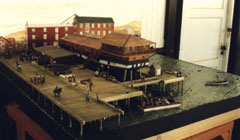 |
|
|
|
|
|
|
|
|
|
|
1999
-- created
for the San Francisco Maritime Museum
Size:
48 in. deep x 48 in. wide
Scale: 1/4 in. = 1 ft. (1/48th scale or O gauge)
Figures: 60 at 1 1/2 in. tall
Features: The Niantic plus (2) "lighters"
(small barges) and a Whitehall rowboat;
a set of piers built on over 200 pilings; horses;
wagons; carts; barrels; crates; sacks; a fisherman (with a ‘bamboo’
pole made from a cat’s whisker); rats; dogs; seagulls; a derrick
at work and piles of discarded goods worth less than the cost of storage.
|
|
|
|
|
|
|
|
|
|
|
|
|
|
|
|
|
|
|
|
|
|
| The Problem:
The San Francisco Maritime Museum wanted a diorama as part of a new permanent
exhibit celebrating a sailing vessel, the Niantic, which had played an interesting
role during the early months of the California Gold Rush, circa 1850. One
of over 700 ships left abandoned in the San Francisco Bay when the crews
opted for life in the gold fields over life at sea, the Niantic was the
first of several ships to be dragged up onto the mud at the shore of Yerba
Buena cove and converted to land-based uses. Quickly surrounded by piers,
she was converted into warehouse space forward and below. In the stern and
in the newly-added top floor there was a rooming house, a printing business,
and bank business offices. (The exploding population overwhelmed all available
space and building materials.) The Niantic burned to the waterline in 1851
during one of six major fires to ravage San Francisco in 2 year period,
and her resting place had been covered by fill, eventually stretching seven
blocks into the bay. Although the remains of the ship were discovered during
1978 excavations for new construction, and some artifacts were recovered,
no one had a clear understanding of what such a diorama should include.
The two etchings below were relied upon heavily as guides with some basis
in truth as they date from the period. |
|
|
|
|
|
|
|
| |
|
|
|
|
|
|
|
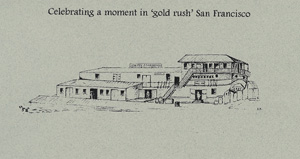 |
|
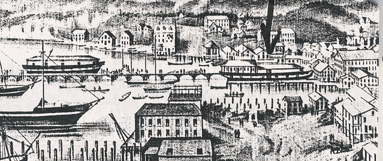 |
|
|
|
|
|
|
|
|
|
|
|
|
|
|
|
|
|
|
|
The Challenge: Research
the story of the Niantic and her surroundings, both physical and cultural,
during the 18 months between her land-based conversion to her demise at
the hands of arsonists, then design and create a diorama that would dynamically
show museum visitors a moment during that time.
|
|
|
|
|
|
|
|
|
|
|
|
|
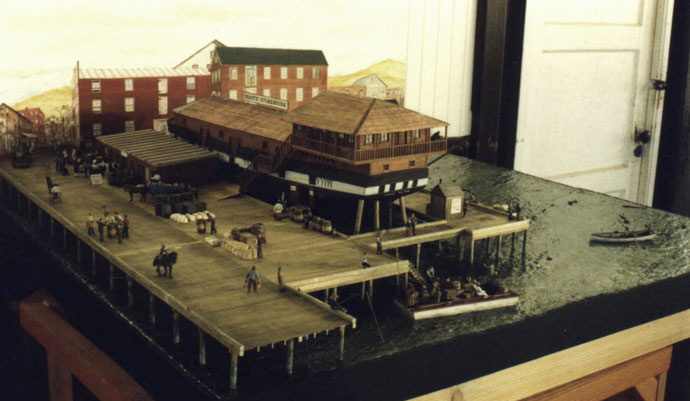 |
|
|
|
|
The Solution: Several days of research at the San
Francisco Maritime Museum archives and other resources in San Francisco,
including first-hand examination of actual artifacts from the excavated
hull of the Niantic, identified a wonderfully rich palette of details
that helped us develop a robust story about a typical morning around the
Niantic, with the commerce of the day in full swing. We were able to employ
Tom Fordham, ship modeler of merit from Pacific Grove, CA, to create the
ship, configured as she was, without masts and with the main deck covered
completely by the enclosed and roofed structure that was added to increase
the warehouse area - a wonderful centerpiece for the scene.
|
|
|
|
| |
|
|
|
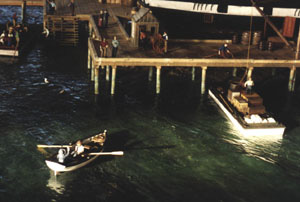 |
|
The incoming tide brings commerce
and more people... |
|
|
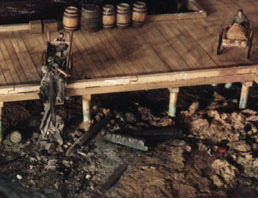 |
|
|
|
|
|
| |
|
|
|
|
|
| |
the outgoing tide takes the debris and the excess. Fires
were common, many set by looters.
|
|
|
|
|
|
|
|
|
|
|
|
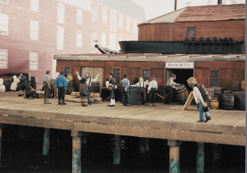 |
|
Many auctions happen daily near the waterfront
as newly arrived goods are saught by newly arrived people. |
|
|
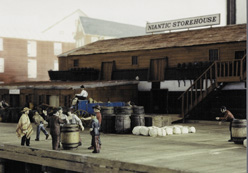 |
|
|
|
|
|
|
|
|
|
A pick-pocket makes off up the pier after grabbing the
purse of a new arrival who has been engrossed in a sharpy's shell game.
Warehouseman at right yells a warning.
|
|
|
|
|
|
|
| |
|
|
|
|
|
|
|
|
|
| |
The piers are supported upon 200 pilings,
sunk through the “water” which covers 90% of the 4’x4’
base.
|
|
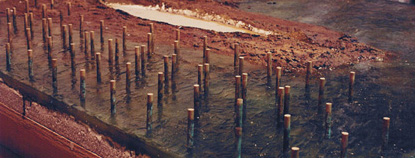 |
|
|
|
|
|
|
|
|
|
|
| |
|
|
|
|
|
|
|
|
|
| |
|
|
|
|
|
|
|
|
|
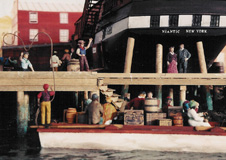 |
|
Two lighters (30’ long barges) ride
on the gentle swells, after transporting cargo from ships moored in deeper
water. One offloads freight and the other new citizens, each dressed in
the telltale garb of their cultural origins.
|
|
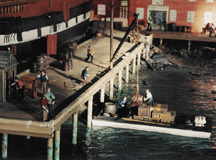 |
|
|
|
|
|
|
|
|
|
|
|
|
|
The water is created with a technique that we have
developed, and the results are, frankly, stunning.
|
|
|
|
|
|
|
|
|
|
|
|
| |
|
|
|
|
|
|
|
|
|
|
|
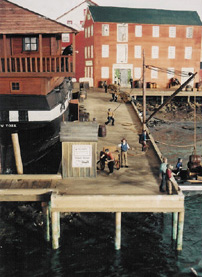 |
|
|
An industrious one-armed
"Fresh Water" vendor buys a fill-up for his cart from the artisian
well water supplier on the end of the pier, one of several enterprises of
the Niantic's owners. The well was discovered quite by accident when they
were driving the pilings to stabilize the Niantic's hull upon the mud. |
|
|
|
|
|
|
|
|
|
|
|
|
|
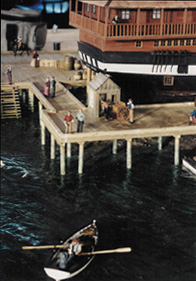 |
|
|
|
|
|
|
| |
|
|
|
|
|
|
|
| |
A shipping agent in a rowboat carries
on negotiations with two different warehouse agents on the pier and the
banker on the top level balcony as he seeks his best deal on a load of
goods he wants to buy.
|
|
|
|
|
|
|
|
|
| |
|
|
|
|
|
|
|
| |
|
|
|
|
|
|
|
|
|
|
|
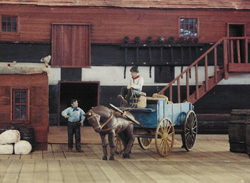 |
|
At left, a San Fransisco merchant has come to the Niantic
Storehouse to pick up a wagon load of merchandise he has stored there
so he can replenish his shelves in town.
At right, the sign over the door says "STORAGE
FOR TRUNKS". The new arrival in the white ethnic tunic has decided
to lighten his load in anticipation of his first day of exploration of
this unique city.
|
|
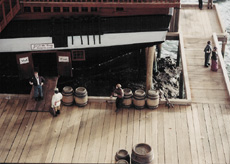 |
|
|
|
|
|
|
|
|
|
|
|
| |
|
|
|
|
|
|
|
|
|
|
|
| |
|
|
|
|
|
|
|
|
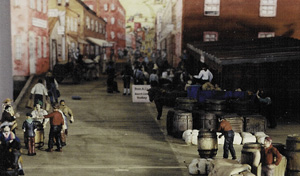
The backdrop painting (acrylic, by MIT) depicts buildings
of the period identified through the few photos available from 1850. The
pier is depicted as continuing on to the shore to become Clay Street as
it rises (to this day) up the hill.
|
|
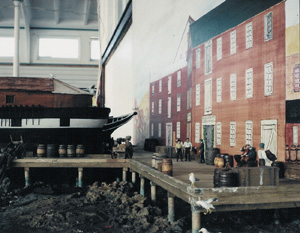
The dumping of dirt and sand from hand excavation of new building sights
up the hill eventually extended the shore 7 blocks east into the bay. |
|
| |
|
|
Mr. Jim Delgado, director of the Vancouver, BC Maritime
Museum, was with the San Francisco Maritime Museum during the excavation
in ‘78. He became a champion of her story and remains one today.
He agreed to provide the final word when historical evidence of a detail
was contradictory, an agreement that the client enthusiastically endorsed.
|
|
|
|
|
Website designed by Moments In Time Exhibits
Contact webmaster
with comments/questions.
|

